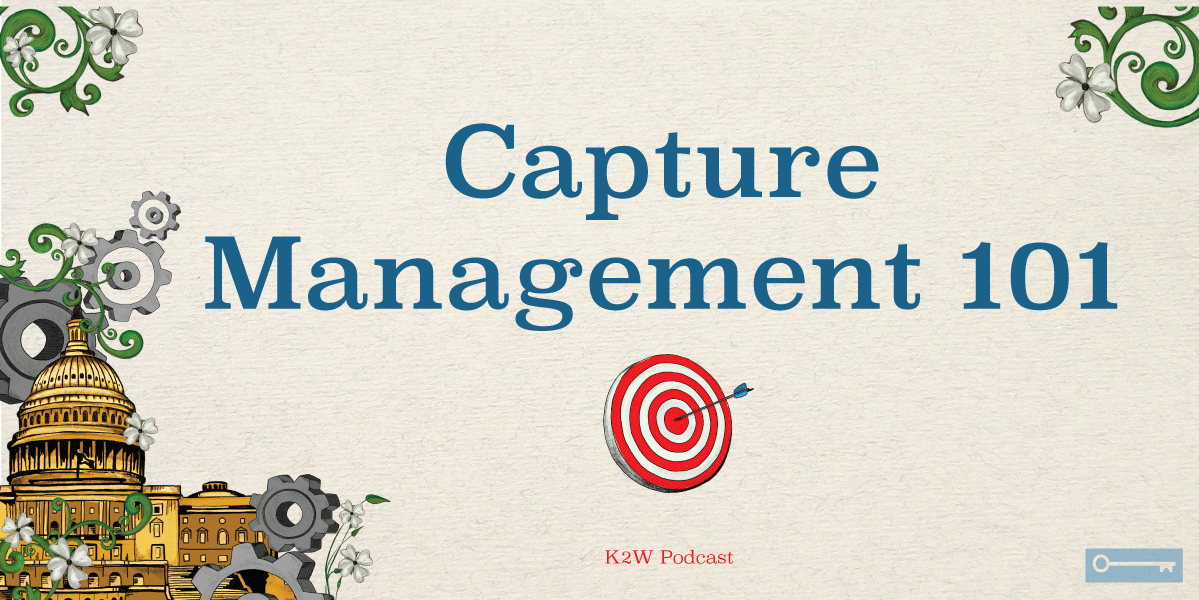How can companies in the GovCon space use their website to draw in customers?
We talk to Meg Kerns, a Digital Marketing Strategist on how small businesses in GovCon can use their digital presence to turn "cold leads" into "warm handshakes."
Guest: Meg Kerns, Owner, MOKup Media
Click the orange play button to listen to the episode. You can also listen on Apple I-Tunes or Soundcloud.
Prefer to read? Here's the episode transcript with resource links.
Ray Thibodeaux: Welcome to Keys to Winning, a podcast where we talk about government contracting topics such as proposal development, business development, win strategies, and more. Keys to Winning, produced by AOC Key Solutions, a leading bid and proposal development firm, gives you a chance to learn from leaders and experts in their fields. I'm Raymond Thibodeaux, today's host of Keys to Winning.
Ray Thibodeaux: Clearly we live in an information age with the internet being a key driver. To thrive, businesses are having to cope with an over abundance of websites, blogs, and social media apps to maintain their public presence. But how do companies harness the power of the web to draw in customers and clients? To talk about that is Meg Kerns, a digital marketing strategist. Her agency, MOKup Media, helps small businesses expand their digital presence.
Ray Thibodeaux: Hi, Meg. Thank you for being on the podcast.
Meg Kerns: Hi, Ray. Thank you so much. I'm excited to chat today.
Ray Thibodeaux: Let's just dive right in. It seems as if businesses maintaining a web presence is just as important as a local physical presence, actual brick and mortar, maybe more so for federal contractors. Is that fair to say?
Meg Kerns: Very, very much so, and that's because most people have their heads down either in their email, their phone, their laptop or some other sort of device that they're using. Most often they're not going out in the public. They're not headed out to lunch and seeing places along the way and just stopping by. So having a presence online, where you can be easily accessible, is insurmountably important when it comes to kind of growing your network as well as your potential business opportunities.
Ray Thibodeaux: Is there a generational aspect to this? It seems like for small businesses tend to be younger entrepreneurs who are more hip to the power of social media as a marketing tool.
Meg Kerns: That is definitely part of the case. The other part of it is that some of the bigger corporations and some of the old good guys group, they have marketing departments as part of their businesses that are able to take this on on their own. Most small businesses and entrepreneurs are actually doing this either solo or with very small teams. So it's more cost effective to outsource to somebody like me who's able to kind of either walk them through the process or actually do it for them in order to keep that presence up so they can really work the front lines of their business to meet new people and to get that growth and to actually find themselves as a resource to others in the space.
Ray Thibodeaux: More and more we're hearing about clicks, not bricks. A hopeful idea that web apps and social media platforms will eventually overtake brick and mortar in terms of generating revenue. The idea comes mostly from the retail sector. Of course, pure click retailers like Amazon come to mind, but do you see something similar happening for those in the federal contracting community?
Meg Kerns: I think the federal contracting community is really moving toward that, especially in the small business space because they have utilized coworking spaces. And so a lot of times they don't have one specific place that they are. They have several different offices because they have a team that works remote. Or they have different places in Arlington, in Tysons and DC. And to keep costs down in that space, they're using places like WeWork or Eastern Foundry or something of that sort, in order to use those spaces. So they don't have one specific location in order to meet the needs of a greater area. Because of that, they're able to move more towards the digital space because they don't have to be in one place all the time, so they're not saying, "Hey, come by my office." They're saying, "Hey, join me on this webinar." Or, "Grab a video Zoom call with me," to meet in that way and make things a little bit easier when it comes to the barrier of meeting face to face.
Ray Thibodeaux: Is there a federal agency or department within an agency that comes to mind as being very online savvy?
Meg Kerns: I actually went to a conference in the recent past, and one of the speakers was the social media strategist for the CIA, which I found very interesting because if you're going to think of clearance based businesses, the CIA is probably one you wouldn't expect to see online. But even they have a digital presence. Now, everything is pretty locked down, and they're very restricted in what they can actually share, but they still have found that there is an importance in having a presence in order to conduct business in the way that they see fit going forward with the new generation of employees that are going to be coming their way. So while they have a presence, their tone and their voice in that presence is very stereotypically CIA.
Ray Thibodeaux: Is there a checklist of must-haves to ensure your company has a solid web presence? I imagine LinkedIn is probably on that list.
Meg Kerns: If you are a federal contractor, LinkedIn is going to be the place that your audience is hanging out. So depending on what business you are working in, what industry, what part of the industry you're working, that's going to dictate where you're going to have your best success online. Clearly LinkedIn is pretty much the place that I always recommend. Twitter is a close second because often you can tap into some of the different industries and their events, awards season, different things like that. But my feeling is that when somebody is searching for services in your industry, you want to be able to show up and take up what we call the half-sheet on Google. When you're searched, or when somebody in your industry is searching for what it is that you do, you want your content to show up before they have to start scrolling down the page on Google.
Meg Kerns: The more options you have for that via LinkedIn, your website, your Twitter, your Google Maps option, any of those things are going to add to the possibility that you're going to rank in social. I'm always an advocate for having a hub, some sort of website because you own that space, typically. LinkedIn, you don't own. So if something happens and that platform tends to go away, you don't want to have all of your eggs in that one basket for digital marketing. You want to make sure that you have your own space, which then does come down to something such as your email list, where you can reach out and actually have those touchpoints, personally, in somebody's email box without being too intrusive.
Ray Thibodeaux: When it comes to online media, there seems to be a way of presenting oneself, kind of like an avatar of one's company or one's self. Are there any guidelines for how a company presents itself on the web?
Meg Kerns: Of course. It's basically the way that you behave online. The way that I typically utilize netiquette within my business and my clients is that if it has to do with religion, politics, or something that belongs on TMZ, we're probably not going to share it unless that's our line of work. We are a political agency, clearly, that's something that we're going to share, and we're going to use our voice in that tone. But having a presence that's well-rounded, that shares information within your brand specific voice and that utilizes the tone appropriate for the situation is going to help frame that netiquette and the way that you behave online with others. Really, you're just keeping yourself from getting into some sort of social fire that you're going to have to put out later.
Ray Thibodeaux: With small businesses, do you find yourself helping them build their image or establish their image online, or do they usually have that in place already, and then they come to you to carry it forward?
Meg Kerns: Most of the time they know who they are. If it's a solopreneur or a small team of an entrepreneur, then that's typically going to be a voice aligned with whomever the leader is. And so sometimes we do have to tweak that to make it more general when their team starts to grow, and so it's a voice that's going to encompass more than just the one person. Typically, when businesses are starting out with a digital presence, they have an idea of who they are and who they serve, but it's then discovering and working with them to develop the way that they want to be of value to those that are following them. What adjectives do they use to describe themselves? Are they educational? Are they helpful? Are they sarcastic? And how does that frame the way that they share content?
Ray Thibodeaux: Many companies offer content such as blogs and podcasts, like this one, which serve two purposes. One is marketing, but what is also establishing a company presence and an industry-wide conversation, maybe even becoming a thought leader in the field. Is it possible to track how these strategies are working and assess their hard value in terms of sales?
Meg Kerns: Very much so. We call that social ROI. The return on the investment that you're taking on the time that you're putting into creating this content can be measured, but it's often measured in things other than dollars. Marketing and digital marketing, especially, bridges the gap between the cold leads, that you're just reaching out to and hoping someone will answer, to a potential warm handshake in person. Typically, I believe they say it takes seven to 10 touches in order for somebody to start to know your brand, to like your brand, and trust your brand in order to either follow you or create some sort of conversion. Whether that be adding to your email list or subscribing to something that you're doing on a YouTube channel, or even then becoming a paid client or a returning customer. All of those things are ways that can be tracked.
Meg Kerns: I also typically tell people that it's going to take a minimum of 30 days to see if something's working. A lot of that has to do with the amount of effort that they're choosing to put in. If they create a blog or a podcast but don't do any social promotion behind it, then the returns are not going to be as great. So they're going to take the time to write it and put it out. But if they're not sharing it with the masses, if they're not consistently pointing towards it, or asking others to share it, then the return there is not going to be as big because not as many eyes are going to see it. Usually, I do request that we take 60 to 90 days to see if a new strategy is working. That doesn't mean you do something and let it sit for 60 to 90 days, but it doe mean that you keep tabs on it, small tweaks here and there, but don't scratch something completely just because you haven't seen it turnover right away.
Meg Kerns: When new businesses, or businesses who don't have digital presences, start one, they typically find a lot of success in that first month. Part of that can be attributed to the fact that they weren't doing anything before. So they get very excited right after they start because they're like, "Oh my gosh, we have a 400% growth on our followers," which is great. You like all of those things. But the consistency and continuing to do the work to create that social presence is going to be what showcases the work versus that doesn't work.
Ray Thibodeaux: What do you mean by customer touches or touchpoints?
Meg Kerns: It's touchpoints. It would be either posts on your LinkedIn where people are interacting. It would be emails. So part of your email funnel or your outreach or your newsletter. It could be tweets where you're tagging people. It depends. Many people are going to see content come across their feed six or seven times before they even take time to stop and let that sink in and read it. They'll scroll past it, and they'll see the name and go, "Oh, yeah, okay." And then eventually they are like, "Well, I keep seeing this somewhere. Maybe I should pay attention." So it's going to take six or seven posts, Instagram pieces, Twitter pieces, email blasts, whatever it may be, for them to actually pay attention. We call that lurking. Most times people tend to lurk in the background and read, but not interact, until they decide that it's worth their effort to put a comment, to like something, or to share something.
Ray Thibodeaux: So it looks like persistence pays off here too.
Meg Kerns: Very much so. Consistency and persistence are both keys, which is where a lot of people tend to falter because they find it takes a lot of time to do some of these pieces. And so if they don't have a routine or a structure in place, it becomes a little bit cumbersome. So once you find out what that flow is and how that consistency plays into what it is you're creating as part of your workflow, that becomes a little bit easier. And then you find greater success as you continue to build that process.
Ray Thibodeaux: It seems inevitable that we'd reach some sort of equilibrium between clicks and bricks. I could be wrong, but even companies that have a dynamic web presence, including webinars and so forth, still tend to rely on traditional face-to-face glad-handing to build rapport and get a lay of the land, so to speak. In the federal marketplace. Do you see even that aspect of business development going the way of the horse and buggy?
Meg Kerns: I wish you could see me. I'm just shaking my head over here. It's because there's nothing that's going to replace a handshake. There's nothing that's going to replace somebody sitting down at lunch or at a meeting or an event where they can talk to you and see your face and hear what it is you're doing. As much as we would love for it to be a Field of Dreams type thing, where if you build it, they will come. It tends to be moreso that meeting people is always going to be best. So if you can use your digital presence in order to build some of that know, like, and trust factor in the beginning, when somebody gets to the point that they meet you at a networking event or they see you at a conference, or they're noticing that you've shown up several places, they're already going to have a positive interaction with you. And that will help them to further the journey down from somebody who's a cold lead to somebody who is a potential pay customer or client. Because the human piece is the biggest piece of any business.
Ray Thibodeaux: This has been an interesting conversation. Thank you, Meg.
Meg Kerns: Thank you. Thank you. I like sharing these kinds of things.
Ray Thibodeaux: I'm Raymond Thibodeaux, and this has been Keys to Winning from AOC Key Solutions Incorporated, or KSI, a consulting firm that has helped companies across the country win billions of dollars in federal contracts. Learn more at www.aockeysolutions.com, or follow us on LinkedIn. Be sure to subscribe for more podcasts in this series, and thank you for listening.
Like this interview? Check out Meg's videos on Linked In for quick social tips!
ABOUT KEYS TO WINNING:
Keys to Winning is a podcast that shares practical advice for GovCon professionals from industry experts. Topics covered include Proposal Development, Government Contracting, VOSBs, WOSBs, and more. Episodes are 15 minutes or less and are posted bi-weekly on Thursday morning. The podcast is hosted by Raymond Thibodeaux, a Senior Proposal Specialist with AOC Key Solutions.







